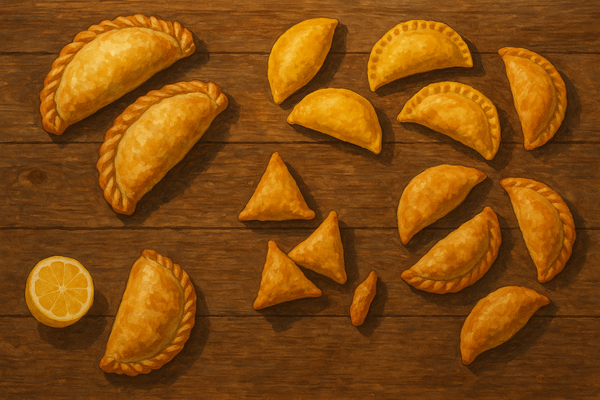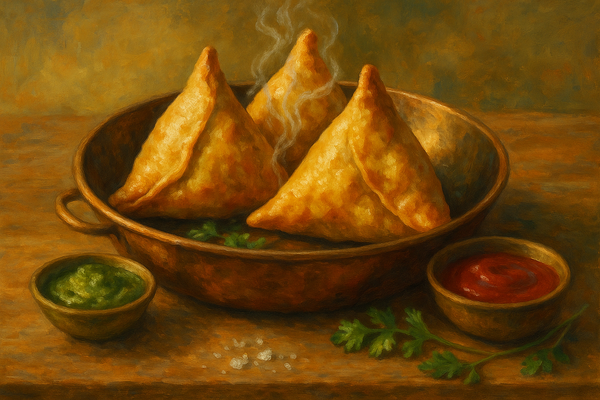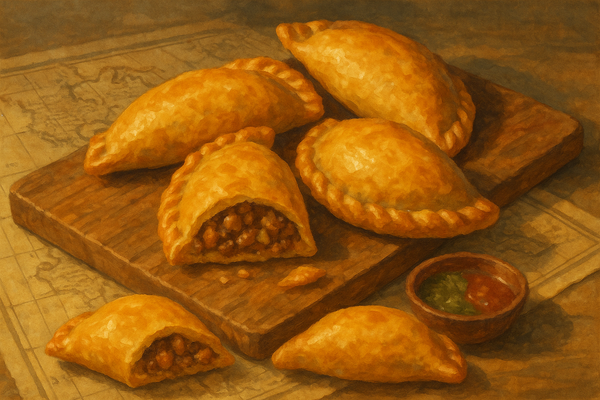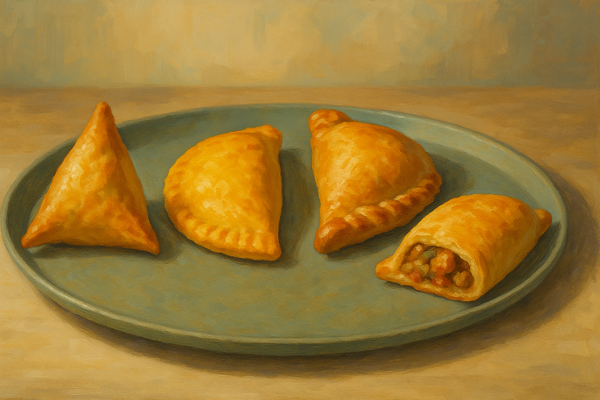
The Empire That Baked
Before it traded spices or tea, the British Empire exported a different kind of power: the habit of wrapping dinner in dough.
Everywhere it went, it carried its appetite — for meat, for pastry, for the feeling of holding a meal in one hand while the world shifted beneath the other.
The Cornish pasty started it. A miner’s lunch, folded over so no coal dust could touch the food inside. Thick edge, solid seam, simple logic.
But when that same idea traveled — on ships, through ports, into colonies — it changed shape.
It met new climates, new flours, new fillings.
And what started as a portable lunch became a map of empire itself.
The Cornish Beginning

Cornish pasties weren’t born of luxury. They were blue-collar ingenuity.
The pastry was a container and a contract — hearty enough to survive a shift underground, thick enough to keep fingers clean.
Its folded edge wasn’t meant to be eaten. Miners tossed it aside to avoid contamination from arsenic-laced hands.
When Cornish miners migrated in the 1800s — to South Africa, Mexico, and Australia — the pasty came too.
It became a kind of edible passport, instantly recognizable, endlessly adaptable.
Wherever there was mining, there was pastry.
And wherever there was pastry, it started picking up an accent.
The Jamaican Patty: Spice Meets Survival

In Jamaica, British colonizers brought the pasty.
Locals — influenced by African, Indian, and Chinese flavors — made it their own.
They swapped suet for turmeric-laced dough, added Scotch bonnet heat, and folded it into something the British never saw coming: a pastry with rhythm.
What was once a miner’s meal became a street food that pulsed with Caribbean spice.
Where the Cornish pasty muted flavor, the Jamaican patty turned up the volume.
Curry, thyme, and chili replaced beef and rutabaga. The filling became a manifesto: We took your crust and made it sing.
It’s no coincidence that Jamaican patties followed Caribbean migration to London, Toronto, and New York.
They became proof that food remembers better than people do.
The Australian Meat Pie: British Comfort, Antipodean Appetite

In Australia, the pie stayed closer to its roots — but got louder, saltier, and more democratic.
Meat pies became national shorthand for hunger and humor: eaten at footy games, gas stations, and midnight diners.
Where the British version was domestic and polite, the Australian one was rowdy and unpretentious.
Thicker gravy, deeper crust, more ketchup.
It wasn’t about refinement. It was about belonging.
If the Jamaican patty rebelled, the Australian pie evolved — proof that empire’s influence isn’t just domination, it’s absorption.
The filling changed with the climate: kangaroo, lamb, peppered steak. But the logic stayed: pastry first, politics second.
The Indian Samosa: The Empire in Reverse

Here’s the twist: the samosa predates British rule by centuries.
But under colonialism, it became one of the few foods that moved in the opposite direction — from colony to colonizer.
British officers developed a taste for them, bringing them back to England as a kind of edible souvenir.
And just like that, the idea of spice wrapped in pastry — the same instinct as a Cornish pasty — circled back, wearing new clothes.
Flour, fat, and fire make strange travel companions.
They don’t care who’s in charge. They just adapt to whoever’s hungry.
The Spanish Empanada: A Parallel Story

The British weren’t alone in exporting crust.
The Spanish were already doing it, centuries earlier, through their own empire.
The empanada — from empanar, “to wrap in bread” — reached Latin America on the same trade winds that carried silver and slaves.
It evolved the same way: local ingredients, global template.
Meat and spice, wrapped in dough, made portable by necessity.
So when British settlers brought their pies across oceans, they were unknowingly repeating an older pattern — the language of power written in pastry.
The Science of Comfort and Control

There’s chemistry behind this story too.
Fat and flour bind into something that holds moisture but resists chaos — a crust that organizes what’s inside.
That’s the same psychology that drove empire: containment, control, the illusion of order.
Pastry is civilization’s comfort blanket.
It promises safety in a world that’s anything but.
When colonizers crossed oceans, they brought pies because they were edible structure — food that obeyed.
And everywhere it landed, someone added heat, color, and noise until the crust cracked and flavor spilled out.
That’s how food evolves. It resists being owned.
The Modern Table

Today, the same family of foods sits side by side in cities that once defined “the world.”
London sells Jamaican patties next to Cornish pasties.
Melbourne serves curry puffs beside steak pies.
Empanadas fill bakery windows in Manchester.
Each one carries a passport stamped with both power and survival. You can taste empire in every bite — but you can also taste how it unraveled.
The crust stayed the same. The fillings changed the story.
Conclusion: What We Keep
A pie is never just pastry. It’s a memory of movement — of who held power, who baked, who adapted, and who refused to disappear.
Empires fall. Recipes stay.
They travel lighter than flags.
And if you bite into a Jamaican patty or a samosa today, you’re tasting not just spice or dough, but centuries of exchange — hunger meeting invention, oppression meeting resilience.
Food doesn’t forgive. It remembers.
And sometimes, it remembers better than history does.
